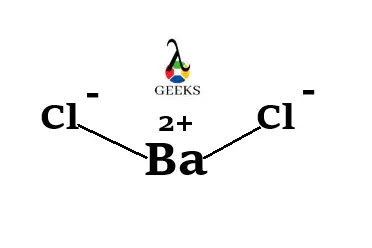Barium chloride properties would reveal the formation of Barium chloride from Barium (Ba) and Chlorine (Cl) atoms. Let us describe Barium chloride properties below.
Barium chloride properties refer to the definite chemical and physical properties held by the compound. The combination of Barium and Chlorine atoms has provided unique properties in the compound. Properties define the facts such as melting and boiling points, viscosity, reactions and others.
The properties of Barium chloride can signify the formation of the compound by illustrating internal processes happened among Barium and Chlorine atoms. Two Chlorine and one Barium atom combine with each other to generate Barium chloride. The properties would be described throughout the article.
Barium chloride IUPAC name
The IUPAC name of Barium chloride is same as “Barium chloride” and “Barium dichloride.”
Barium chloride chemical formula
The chemical formula of Barium chloride is BaCl2, which signifies that two Chlorine atoms create bonds with the central Barium atom.
Barium chloride CAS number
The CAS (Chemical Abstract Service) registry number given to BaCl2 is 10361-37-2.
Barium chloride ChemSpider ID
The ChemSpider Identity number of Barium chloride is 23540.
Barium chloride chemical classification
The chemical classifications of Barium chlorides are as follows:
- Barium chloride is found as an inorganic compound.
- Barium chloride is considered as a mild salt.
- Barium chloride is found to be hygroscopic by nature.
- Barium chloride is highly soluble in water.
Barium chloride molar mass
The molar mass of Barium chloride has been examined as 208.23 g/mol.
Barium chloride colour
Barium chloride is pure white in colour. In contact with fire, it gives light green colour of flame.
Barium chloride viscosity
Viscosity of Barium chloride has not been calculated properly as the compound is completely soluble in water.
Barium chloride molar density
Molar density of anhydrous Barium chloride is 3.856 g/cm3 whereas the molar density of dihydrate form of Barium chloride has identified as 3.0979 g/cm3.
Barium chloride melting point
The melting point of barium chloride has been obtained as 960 °C.
Barium chloride boiling point
The specific boiling point of barium chloride has been examined as 1560 °C.
Barium chloride state at room temperature
Barium chloride is found in a solid state at room temperature.
Barium chloride ionic bond
Barium chloride is made of ionic bond between one barium cation and two anions of chlorine.

Barium chloride ionic radius
The ionic radius of Barium in Barium chloride is found as 222 pm.
Barium chloride electron configurations
Electronic configuration is defined as the electron arrangement in the atomic orbitals of individual elements. Let us identify electron configuration of Ba and Cl atoms in BaCl2.
Electron configuration of barium is 1s2 2s2 2p6 3s2 3p6 4s2 3d10 4p6 5s2 4d10 5p6 6s2. Besides, the electronic configuration of Chlorine is 1s2 2s2 2p6 3s2 3p5.
Barium chloride oxidation state
In Barium chloride, the oxidation state of barium is +2 and the oxidation state of each chlorine atoms are -1.
Barium chloride acidity/alkaline
Barium chloride is neither acidic nor alkaline with a neutral pH level.
Is Barium chloride odourless?
Barium chloride is clearly an odourless salt.
Is Barium chloride paramagnetic?
Paramagnetic elements are noticed to possess unpaired electrons in their electron shells. This is same for compound as well. Let us found if BaCl2 is paramagnetic or not.
Barium chloride is not a paramagnetic compound, which is completely filled with paired electrons in the orbitals of both barium and Chlorine atoms.
Barium chloride hydrates
Three types of hydrates of Barium chlorides are found below:
- Barium chloride anhydrous (BaCl2)
- Barium chloride hydrate (BaCl2, H2O)
- Barium chloride dihydrate (BaCl2, 2H2O)
Barium chloride crystal structure
Barium chloride has a crystalline structure.
Barium chloride polarity and conductivity
- Barium chloride is found to be a polar compound. A specific amount of dipole moment is aroused in barium chloride due to a huge difference in electronegativity between Barium and Chlorine atoms.
- Barium chloride is found to be conductive as it gets dissolved completely in water.
Barium chloride reaction with acid
The reaction of Barium chloride with H2SO4 gives out Hydrochloric acid.
BaCl2 + H2SO4 = BaSO4 + 2HCl
In reaction with Nitric acid, Barium chloride gives out Barium nitrate and Hydrochloric acid.
2HNO3 + BaCl2 = Ba(NO3)2 + 2HCl
Barium chloride reaction with base
Barium chloride makes a precipitate of Barium hydroxide after a late reaction with sodium Hydroxide. BaCl2 + NaOH = Ba(OH)2 + NaCl.
Barium chloride reaction with oxide
Barium chloride is not much reliable in reaction with different oxides. Only in the reaction of barium chloride with NO2, Barium nitrate takes place as a product.
BaCl2 + NO2 = Ba(NO2)2 + Cl2
Barium chloride reaction with metal
In reactions with different metals such as Iron and Copper, Barium is identified as the foremost product of the reactions.
- Fe + BaCl2 = Ba + FeCl
- Cu + BaCl2 = CuCl + Ba
Conclusion
Barium chloride is a simple water-soluble inorganic compound in chemistry. This is suitable for delivering general knowledge about the reactive nature of Chloride salts. The definite structure of BaCl2 is noticed to embrace common knowledge regarding active participation in different chemical reactions.

Hi…..I am Sarnali Mukherjee, a graduate from the University of Calcutta. I love to teach and share knowledge on chemistry. I have gradually gained interest in article writing since one year ago. I would love to acquire more knowledge on my subject in the future.
Let’s connect through LinkedIn: